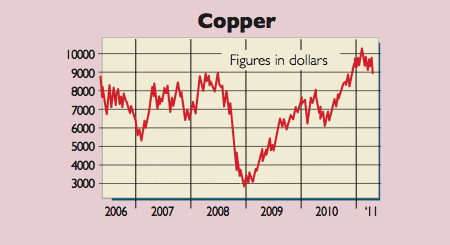The commodities boom is not over - buy on the dips
Commodities are becoming scarcer, but as resources get harder to come by, opportunities crop up for canny investors. John Stepek looks at the key influences on commodities prices, and picks the best investments to buy now.

Commodities are becoming scarcer, but as resources get harder to come by, canny investors can spot opportunities, says John Stepek.
Almost exactly a year on from the 6 May 2010 'flash crash', which saw the Dow Jones Index plunge by 1,000 points in the course of a single day's trading (before bouncing back), it seems commodities may have experienced their own 'flash crash'. By the end of last week, silver had tanked, oil had seen its biggest single-day dollar loss on record, while the Standard & Poor's GSCI Index of 24 commodities had fallen 11% in five days, the most since December 2008.
Yet the correction didn't last long. On Monday, after a weekend of headlines about 'commodity routs' and comparisons with the tech bubble, commodities were rebounding. Goldman Sachs which had forecast the slump in the first place was suggesting investors might want to get ready to buy in, ahead of a comeback in the second half.
Subscribe to MoneyWeek
Subscribe to MoneyWeek today and get your first six magazine issues absolutely FREE

Sign up to Money Morning
Don't miss the latest investment and personal finances news, market analysis, plus money-saving tips with our free twice-daily newsletter
Don't miss the latest investment and personal finances news, market analysis, plus money-saving tips with our free twice-daily newsletter
And perhaps it's little wonder. The growth of emerging markets, aided and abetted by speculators taking advantage of loose monetary policy, have been viewed as the main drivers behind the commodity boom. But now Jeremy Grantham of US fund manager GMO warns that we might be running out of well, everything. In his latest, rather worrying quarterly letter, Grantham summarises his 19-page argument as follows: "The world is using up its natural resources at an alarming rate, and this has caused a permanent shift in their value. We all need to adjust our behaviour to this new environment. It would help if we did it quickly."
See also
The longer version of his argument is that up until 1800 or so, the size of the human population was basically determined by availability of resources. If we ran out of food, we starved. If we had a surplus, we bred until we'd consumed it. Then we found oil. That massive energy boost allowed us to boost the food supply and our broader standard of living dramatically over the following centuries.
But now we're running out of oil and most other commodities; crop yield growth is stalling at a time when we don't have much new agricultural land to bring into use; and yet the population just keeps growing. This, says Grantham, rather than loose monetary policy or anything else, is why commodity prices just keep on rising. We're running low, and the market is "sending us the Mother of all price signals". Indeed, says Grantham, while the prices of all important commodities except oil were in decline in the 100 years before 2002, this "entire decline" has been erased in the years since then.

Scary stuff indeed. But I suspect the more contrary-minded among you are thinking as you should be 'isn't this a sign to sell commodities?' After all, Grantham is making a "this time it's different" argument (although I suppose you could make the case that what he's actually saying is that it's the last 200 years or so that have been 'different' and now we're reverting to the mean). But in any case, don't be too hasty. For one thing, Grantham knows all about bubbles he's a well-known value investor who has made a study of all of the biggest ones. For another, while he is bullish on commodities in the long run, he's a little more wary in the short term.
The key threats to commodity prices
The clearest threat to commodity prices as Grantham points out is that "a wheel comes off China's economy". As Mark Williams of Capital Economics notes, China's annual inflation rate in April may have slipped to 5.3%, but that's still uncomfortably high compared to the government's 4% target, and also higher than analysts had expected.
It's hard to exaggerate how concerned the Chinese leadership is about inflation. For example, consumer goods giant Unilever recently received a fine of around $300,000 for telling the press that it planned to put up prices, thus sparking panic buying of shampoo and detergents.
So the concern is that China will keep tightening monetary policy in an effort to stem inflation. The danger then, as we're regularly reminded, is that all the unproductive investments that have been made as part of China's huge investment splurge on factories, properties, whole towns, roads and railways to nowhere, etc, will be revealed as unsustainable, bad debts will cripple the banking system, and China's economy will hit a brick wall.
However, the fact is that China is already slowing down. Retail spending growth, says Williams, is at its weakest in real terms in six years. Industrial output growth is declining. And that's already having an impact on demand for resources. Jamie Chisholm in the Financial Times notes that "the market has been focused on the wrong raw material". It's not silver everyone should be worried about, but copper. China accounts for nearly 40% of global demand for the red metal. Its price peaked more than two months ago (see chart, left). Why is this relevant? Because copper production and supply is actually quite tight. So, says Chisholm, if it's not down to oversupply, then "it is most likely to be falling demand that is putting pressure on prices".
And it seems he's right. Look, says Julian Jessop, also of Capital Economics, at the volume rather than the value of China's commodity imports. In terms of tonnage, imports of many commodities are "actually falling outright". In April, for example, copper imports were down by 14% on March, and 40% on the year. Imports of aluminium, soy beans and iron ore were also down, while crude oil saw only marginal gains. Simon Hunt of Simon Hunt Strategic Services says that what it comes down to is that the Chinese have been using copper not just for consumption, but also for investment. "At between $9,000 and $10,000 there was difficulty in finding new investment buyers; lower prices are needed for the game to continue."
Another warning sign is that China has been pulling back from commodities deals and acquisitions. Its companies have spent $14.2bn on commodities deals this year, according to Bloomberg, down 30% on the same period last year. Richard Horrocks-Taylor, head of mining investment banking at RBC Capital Markets in London, tells Bloomberg: "Chinese acquirers have become more sophisticated and more thorough in their assessment before they make an offer." Indeed, you could argue that when it comes to commodities, China as the most important consumer is the ultimate insider. If it is losing interest in investing in new acquisitions in the sector, then perhaps that's a warning to the rest of us.
The Fed could surprise us all
Anyone who can look at a chart would have difficulty denying that quantitative easing (QE) has had an impact on commodity prices. As commodities expert Sean Corrigan of Diapason points out, the increase in prices of almost all assets has dovetailed nicely with the launches of QEs one and two. The general consensus in markets for now is that while Fed chairman Ben Bernanke has said there won't be any QE3, he'll be ready and willing to launch if markets tumble when he pulls the liquidity away.
However, this might just might be wishful thinking. One side effect of China's desire to hold down inflation in its own country is that it is allowing the yuan to rise not by much, but at a faster rate than it has for some time. Some argue that Bernanke's main aim in keeping the dollar weak has been to force China to allow its currency to rise. The argument is that ifthis happens, it'll boost US manufacturing and also lift Chinese consumption.
If the US achieves this goal, then perhaps the Fed won't be quite so fixed on keeping the dollar weak. And unlike the UK, the US has already endured a housing crash (in fact, the US housing market is onto a double dip now). So raising short-term interest rates isn't going to cause carnage in the housing market, because it is already nearly as bad as it's going to get. In fact, the best way to help the US consumer now would be to reduce the pain of rising raw-material costs. A stronger dollar could help with that. Sure it might hurt stocks but even in a shareholder democracy like the US, that's a concern more for the wealthy than for the voter in the street.
We're not saying this is a certainty. Bernanke seems to be wedded to the idea that you can only get out of a slump by printing money until you've floated your way out of it. But the Fed might just surprise us (see page 28 for more).
The other thing that might buy us time, says Grantham, is the weather. For farmers at least, global weather last year was "the worst in many decades". Hence, on the balance of probability, it's likely that the coming 12 months will "be more accommodating and, quite possibly, just plain friendly". If that happens, the priceof many agricultural commodities in particular will tank especially because they are so high now that farmers have every reason to plant as much as possible.
Grantham reckons there's an 80% chance of either the weather being better or China running into trouble this year. Either event would send commodity prices a lot lower. If both happen at the same time, it could lead to a collapse in prices and that, reckons Grantham, would be a "once in a lifetime chance" to back up the truck and buy what you can get your hands on.
What to buy
But for now, you need to be picky. So what commodities might still do well? Well, even if you don't agree with Grantham's 'peak everything' thesis (and we hope that there's a lot more that human ingenuity can do to help out on that front), if there's one commodity that we can be fairly sure we're running out of or at least, finding it harder to get hold of it's oil. As Tim Price of PFP Wealth Management points out in his latest email, "we are facing the end of cheap fossil fuels".
While the oil price certainly has a Middle East risk premium in it right now, Grantham believes that in the longer run, we are now into a 'new paradigm' for all prices. Oil traded around a 'real' price of $16 a barrel right up until 1973, but it shifted up to around $35 a barrel when oil cartel Opec was formed. Now Grantham reckons we're looking at an average of around $75 a barrel. The oil price could still be volatile around this the range would typically be "from over $150 to under $37". But if oil is going to trade around a permanently more expensive plateau, that will encourage us to find alternative energy sources.
There are several options we'll look at renewables in a future issue but among the cheapest and most feasible is natural gas. It's also one of the few commodities that hasn't spiked well above its historical average during the current boom. We've talked about shale gas in MoneyWeek before, but to cut a long story short, new technology means the US is now able to access the natural gas hidden in shale. We look at stocks that could benefit below. Elsewhere, we'd stick with gold we like it as insurance. The summer months are often a lull period for the yellow metal, as our precious metals writer Dominic Frisby often points out in Money Morning, but that makes it a decent time to buy in.
John is the executive editor of MoneyWeek and writes our daily investment email, Money Morning. John graduated from Strathclyde University with a degree in psychology in 1996 and has always been fascinated by the gap between the way the market works in theory and the way it works in practice, and by how our deep-rooted instincts work against our best interests as investors.
He started out in journalism by writing articles about the specific business challenges facing family firms. In 2003, he took a job on the finance desk of Teletext, where he spent two years covering the markets and breaking financial news. John joined MoneyWeek in 2005.
His work has been published in Families in Business, Shares magazine, Spear's Magazine, The Sunday Times, and The Spectator among others. He has also appeared as an expert commentator on BBC Radio 4's Today programme, BBC Radio Scotland, Newsnight, Daily Politics and Bloomberg. His first book, on contrarian investing, The Sceptical Investor, was released in March 2019. You can follow John on Twitter at @john_stepek.
-
 Landlords ‘positive’ about buy-to-let market despite Renters Reform Bill
Landlords ‘positive’ about buy-to-let market despite Renters Reform BillNews New research has found landlords are not being put off investing in the rental market, even though the Renters Reform Bill is on its way.
By Henry Sandercock Published
-
 Lloyds Bank unveils new pension service – is it any good?
Lloyds Bank unveils new pension service – is it any good?Lloyds is the first high-street bank to launch a ready-made pension service. How does it work, is it any good and who can save in it?
By Vaishali Varu Published